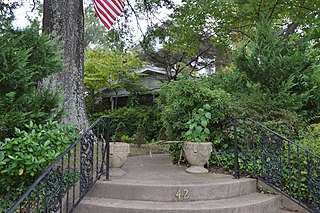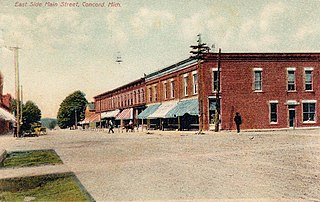
Concord (/ˈkɒn.kord/) is a city in Cabarrus County, in the U.S. state of North Carolina. As of the 2010 census, the city had a population of 79,066, with an estimated population in 2019 of 96,341. It is the county seat and the largest city in Cabarrus County. In terms of population, the city of Concord is the second-largest city in the Charlotte metropolitan area and is the 10th most populous city in North Carolina.

Kingstree is a city and the county seat of Williamsburg County, South Carolina, United States. The population was 3,328 at the 2010 census.

Concord is an unincorporated community in Knox County, Tennessee, United States and is listed on the National Register of Historic Places as a historic district, the Concord Village Historic District. The United States Geographic Names Information System classifies Concord as a populated place. It is located in western Knox County, east of Farragut and west of Knoxville. Mail destined for Concord is now addressed to Concord, Knoxville, or Farragut.

The La Grange Presbyterian Church, also known as the La Grange Rotary Club, is a historic Presbyterian church building located on Caswell Street in La Grange, Lenoir County, North Carolina. It was constructed in 1892, and is a Gothic Revival style frame building.

South Union Street Historic District is a national historic district located at Concord, Cabarrus County, North Carolina. The district encompasses 69 contributing buildings in a predominantly residential section of Concord. The district developed after 1880 and includes notable examples of Late Victorian and Bungalow / American Craftsman style residences.

Hillsborough Historic District is a national historic district located at Hillsborough, Orange County, North Carolina. The district encompasses 529 contributing buildings, 9 contributing sites, 13 contributing structures, and 2 contributing objects in the central business district and surrounding residential sections of Hillsborough. The district includes buildings dating to the late-18th and early-20th century and includes notable examples of Federal, Greek Revival, and Italianate style architecture. Located in the district are the separately listed Burwell School, Eagle Lodge, Hazel-Nash House, Heartsease, Montrose, Nash Law Office, Nash-Hooper House, Old Orange County Courthouse, Ruffin-Roulhac House, Sans Souci, and St. Matthew's Episcopal Church and Churchyard. Other notable buildings include Seven Hearths, the Presbyterian Church (1815-1816), Methodist Church (1859-1860), First Baptist Church (1862-1870), Twin Chimneys, and the Berry Brick House.

The Main Street Historic District is a 21-acre (8.5 ha) national historic district located at Marion, McDowell County, North Carolina. It was listed on the National Register of Historic Places in 1991. In 1991, it included 36 buildings deemed to contribute to the historic character of the area and one other contributing site.

The Concord Village Historic District in Concord, Michigan dates back to 1836, and consists of historic structures located along Hanover Street from Spring to Michigan Streets and North Main Street from Railroad to Monroe Streets. It was listed on the National Register of Historic Places in 1996.

First Presbyterian Church is a historic Presbyterian church located at 12 W. Fort Streets in Marion, McDowell County, North Carolina. The congregation was established in 1845, and the current church building was constructed in 1923. It is a one-story plus balcony Classical Revival style brick building set on a raised basement. The front facade features a monumental Ionic order tetrastyle pedimented portico.

First Presbyterian Church and Churchyard is a historic Presbyterian church on New Street between Middle and Hancock Streets in New Bern, Craven County, North Carolina. It was built in 1820, and is a rectangular frame church building with two tiers of windows. It features a tetrastyle pedimented Ionic order portico and projecting four stage tower topped by an arcaded octagonal belfry. During the Civil War, the church was converted into a military hospital by the Union forces.

Ebenezer Academy, Bethany Presbyterian Church and Cemetery is a historic school building, Presbyterian church, and cemetery located six miles north of Statesville, Iredell County, North Carolina. The log building was constructed in 1823 and housed Ebenezer Academy. The church building was built about 1855, and is a one-story, three bay by five bay, vernacular Greek Revival style frame building with a low gable roof. Also on the property is the contributing church cemetery with burials dating to about 1785.

Concord Presbyterian Church is a historic Presbyterian church located near Winnsboro, Fairfield County, South Carolina. It was built in 1818, and is a one-story, brick, gable-roofed building with a meeting house floor plan. It has a small, rectangular, gable-roofed rear extension and sits on a granite foundation. Also on the property is a cemetery with a cast-iron fence and gates.
Hobart Brown Upjohn (1876–1949) was an American architect, best known for designing a number of ecclesiastical and educational structures in New York and in North Carolina. He also designed a number of significant private homes. His firm produced a total of about 150 projects, a third of which were in North Carolina.

North East Historic District is a national historic district located at North East, Erie County, Pennsylvania. It includes 114 contributing buildings in the central business district and surrounding residential areas of North East. The district includes commercial, residential, institutional, and religious buildings. The buildings were built from the mid-19th to early-20th century and are in a variety of popular architectural styles including Greek Revival, Queen Anne, and Italianate. Located at the center of the district is Gibson Park. Notable non-residential buildings include commercial buildings along East and West Main Street and South Lake Street, the Concord Hotel, the Crescent Hose Company, Baptist Church, Presbyterian Church, and Methodist Church, two main buildings of St. Mary's Seminary, McCord Memorial Library (1916), and Heard Memorial School.
Louis H. Asbury (1877–1975) was an American architect, a leading architect of Charlotte, North Carolina. He is asserted to be the "first professionally trained, fulltime architect in North Carolina who was born and practiced in the state."

The historic Cabarrus County Courthouse in Concord, North Carolina was completed in 1876, replacing one that was destroyed by fire just the previous year. It was designed by architect G.S.H. Appleget. It includes Second Empire, Italianate, Classical Revival, and other architecture. It was listed on the National Register of Historic Places in 1974. In 1975, a new courthouse was built; the historic courthouse is now the home of the Cabarrus County Veterans Museum and the Cabarrus Arts Council. It is located in the South Union Street Courthouse and Commercial Historic District.

South Union Street Courthouse and Commercial Historic District is a national historic district located at Concord, Cabarrus County, North Carolina. The district encompasses 11 contributing buildings in the central business district of Concord. It primarily includes commercial buildings in popular architectural styles including Italianate, Romanesque Revival, and Second Empire style architecture. Located in the district are the Elks Hall, former Town Hall, G. W. Patterson Wholesale Grocery, Pythian Building, Watch Repair Shop, and former Cabarrus Savings Bank (1923-1924). Also in the district is the separately listed former Cabarrus County Courthouse.

Union Street North–Cabarrus Avenue Commercial Historic District is a national historic district located at Concord, Cabarrus County, North Carolina. The district encompasses 14 contributing buildings in the central business district of Concord. It primarily includes commercial buildings in popular architectural styles including Beaux-Arts style architecture. Located in the district are the Bell and Harris-Maxwell Brothers Furniture Store (1921–1924), Yorke and Wadsworth Company Warehouse (1908–1911), Lippard and Barrier Grocery (1908–1911), Concord National Bank and Hotel Concord (1926), Star Theatre, Cannon Building and Concord Theatre, and Horton Building–Commerce and Merchants Building (1952).

Milton Historic District is a national historic district located at Milton, Caswell County, North Carolina. It encompasses 15 contributing buildings in the town of Milton. The district includes notable examples of Federal and Greek Revival style architecture. In addition to the separately listed Milton State Bank and Union Tavern, other notable buildings include the Clay-Lewis-Irvine House, Winstead House, Presbyterian Church, Baptist Meeting House, Old Shops, Old Stores, and row houses. Fittings in the Presbyterian Church and Baptist Meeting House are attributed to noted African-American cabinetmaker Thomas Day.

Salisbury Historic District is a national historic district located at Salisbury, Rowan County, North Carolina. The district encompasses 348 contributing buildings and 1 contributing site in the central business district and surrounding residential sections of Salisbury. It includes notable examples of Late Victorian, Colonial Revival, and Bungalow / American Craftsman style architecture. Located in the district are the separately listed Maxwell Chambers House, McNeely-Strachan House, Archibald Henderson Law Office, and the former Rowan County Courthouse. Other notable buildings include the tower of the former First Presbyterian Church (1891-1893), Rowan County Courthouse (1914), Conrad Brem House, Kluttz's Drug Store, Bell Building, Washington Building, Grubb-Wallace Building, Hedrick Block, Empire Hotel, St. Luke's Episcopal Church (1827-1828), Soldiers Memorial A.M.E. Zion Church (1910-1913), U.S. Post Office and Courthouse (1909), City Hall (1926), Salisbury Fire House and City Building (1897).





















